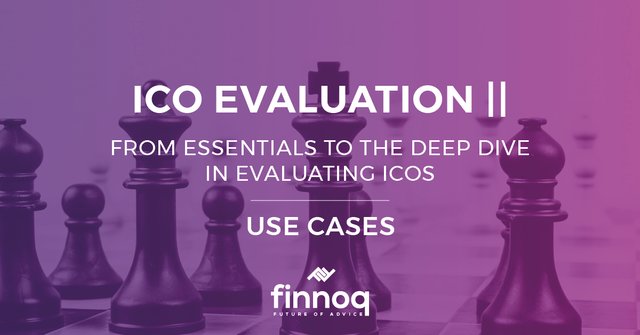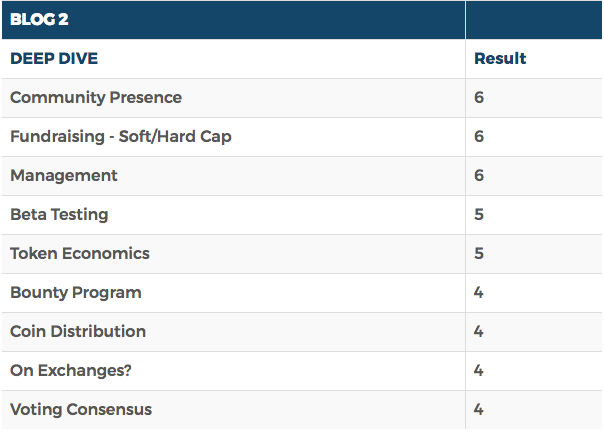Evaluating ICOs 2: from Essentials to the Deep Dive in Evaluating ICOs

In the first blog, we gave you an overview of how you as an investor need more than a ratings website and one industry source in order to put your money into an ICO. Further, we tried to highlight our approach in this ongoing example: many sources are better than one when obtaining financial advice and making sound financial decisions.
At Finnoq, our decentralized protocol is aimed at creating a space for premium, unbiased, and collective advice. With that in mind, let’s continue with our discussion on ICO evaluation. This time, we are taking a look at a few more factors, a bit more complex than the essentials.
We call them the “Deep Dive”, and they are listed below:

CATEGORY 2: DEEP DIVE
Community Presence: 6/11 mentions
Looking at the size and activity of the community (not just the company-paid press releases) as well as company media presence are strong considerations of a potential ICO’s success. Venture capital firms or industry-specific investors put their money where their mouths are, placing their resources with a high degree of confidence once they have the ability to scrutinize the writings of a project. Today when a potential ICO is being marketed on social media, having a look at other people’s perspective can be helpful in knowing what projects are more legitimate than others (until the Finnoq protocol comes out!). Legitimate projects have active, open discussions across social media, including transparency and quick response times from the team. If a team is changing directions with no regard for others, while also not sending the necessary updates regarding such changes, be wary of the project’s ability to succeed post-ICO. As mentioned in part one, transparency is key!References used: 1, 3, 7-8, 10-11
Fundraising - Soft/Hard Cap: 6/11 mentions
How much is the ICO trying to raise and why? What is the minimum and/or maximum fundraising threshold for the ICO, and a hypothetical cap on funds raised? These are some basic questions one has to ask in 2018, as the ICO sphere has become much more complex today than the nascent days of crypto. While some ardently believe that participation in ICOs shall remain with companies touting a definitive soft/hard (minimum/maximum) cap on funds (if the project is pre-product), many ICOs these days even hype a hard/unlimited cap today. By doing so, not only could this create unrealistic and lofty expectations, but there are practical instances where this resulted in no percentage gain for the investors, because too many flocked in during a short period of time. Also, consider how hype could lead ICO participants into a full-blown scam. By having an unlimited cap or no definite time period for ending the token sale, the company exposes itself as being without a solid plan of what it needs to get the project running.References used: 4-5, 8-11
Management: 6/11 mentions
Relevant to fundraising: how many tokens will be owned by the foundation, founders, and team? Is there a plan set out for the management of accounts and audits? In general, the founding team should own between 10% and 50% of the token and should not receive liquidity within the first three years; be suspicious of any team token ownership set at more than 50%. Ask how holdings are calculated as well as for financial projections to ensure there is enough revenue to cover expenses with a margin for growth.References used: 3-4, 6, 8-10
Beta Testing: 5/11 mentions
How much has the product (as integrated on the blockchain) been tested? Besides an alpha, having a beta version or testnet is a good indication that the founding team will be able to “execute their vision”. To that end, a team possessing proof of concept (POC) or minimum viable product (MVP) shows “the personal investment made by founders to develop their idea before seeking funding”. Alternatively, not having a POC or MVP should raise red flags as to whether the project is both viable and credible.References used: 1, 3, 6, 8, 10

Token Economics: 5/11 mentions
The subject of token economics has many facets, and is usually a subject on its own for any one contributor. That being said, without understanding some basics on token economics, a participant might place resources into an ICO that either requires mass adoption of use or pure speculation (discussed in part three) to increase value over time. Immediately post-ICO, what happens if the proposed maximum token supply exceeds the initial circulation? If it doesn’t, what will the team do with unsold tokens? Burning (destroying) or redistributing unsold tokens can also impact the initial value of each token after the ICO and consequently, how participants behave with tokens valued differently than originally intended. Consider the equation of exchange, which states the nominal total of the resource supply multiplied by the velocity of that resource (the frequency as which the unit is being used) is equal to the resource’s price level multiplied by its quantity. The equation looks as follows: M x V = P x Q The token must align incentives to simultaneously accelerate growth and token value. In achieving token value, scarcity of token is one means to achieve the objective. Consider that - for example - indefinitely printing tokens causes an inflationary spiral (as is the case with any currency). Further, if the token only proposes an increase in exchange (V) within its system, growth of revenue (P x Q) becomes compromised, depreciating overall value. Within the protocol itself, is the token’s ultimate reward a result of active or passive work(monetizable reward based on user action versus sharing or disclosing data about the user)? Going back to the aforementioned equation for each ICO will give you a good idea as to the potential of the project in increasing its value over time.References used: 2-3, 5, 9, 11
Bounty Program: 4/11 mentions
It is now commonplace for ICOs to have bounty programs (for example, Finnoq’s can be found here). The company will offer tokens to participants who are willing to promote and refer the ICO, or look at bugs in the code in order to improve the functionality of the protocol itself. With that being said, striking that balance between evaluating community presence (as discussed above) and filtering out the white noise hype is crucial for you the ICO participant. Why? When users are obligated to spread positive information for rewards and stimulate hype around the project (without the necessary objectivity you need to make good decisions), you will receive a skewed perspective of what the company is actually capable of post-ICO. To avoid the counterproductive hype, have a look at website traffic and growth related to the company in order to objectively evaluate if the bounty is overdone or not.References used: 1, 4, 7, 10
Coin Distribution: 4/11 mentions
Related to the business model mentioned in part one and token economics mentioned directly above, coin distribution has many facets within the context of an ICO. When and how tokens are distributed, as well as how token giveaways or discounts are determined (to encourage “hodling” or profit taking upon launch) is crucial in understanding what your expectations should be as a participant in an ICO. Further, tokens should come directly from the blockchain, if possible, in order to ensure that any participant can indeed do so in an exchange for resources.References used: 2, 4, 8, 10
On Exchanges?: 4/11 mentions
Which exchanges will the token be on? Growth of a company conducting an ICO can depend on the amount of exchanges it is listed, if this is a key factor in the realization of returns. Additionally to the later point, if the token is to be listed on many exchanges, the listing of partners and industry/institutional backing of the project is necessary to know both who expressed interest and what their intentions are in collaboration with the project.References used: 1, 3-4, 6
Voting Consensus: 4/11 mentions
Does the ICO in which one wishes to participate grant a governance function, such as voting on a consensus related or other decision-making factor? If so, what is the consensus algorithm used by the project and how was it picked? If not, one must obtain the pertinent information as to whether the coin or token proposed is structured with a centralized or decentralized governance altogether. Perhaps the project itself is predicated solely on governance, and if this is the case, treat the documentation of the project with as great of due diligence as you would under normal situations (go back to the essentials in part one to start).References used: 2, 4, 8, 11
CONCLUSION
This time, we took a deep dive, looking at factors required to evaluate ICOs. As mentioned in the first part, if you read any one of these sources, you’d have part of the map in finding the pirate’s lost treasure. However, in the cryptocurrency space, you need the full map or you’ll get lost at sea. Hence, by receiving a collective statement, we can obtain better, collective advice and make better financial decisions on tokenized assets.By understanding the essentials in the first part as well as the deeper dive taken during part two, you are that much closer to evaluating ICOs properly and effectively. As we move into the third part of this blog, we will discuss the most granular, specific factors to consider when evaluating ICOs. We look forward to hearing your comments on part one, and do not hesitate to contact us with your thoughts on anything Finnoq related.
DISCLAIMER
Although we believe there are 18 factors worth mentioning, it is not for us to decide on the protocol. This is just an example. Our proposed protocol seeks to decentralize power. Thus, it is you the global community who decides what is important knowledge, and not us. Additionally, results in an actualized protocol would be anonymous; thus, attributing answers to particular members of the community would never happen. What we found does not indicate that the source is somehow uninterested in other parts. The authors wrote articles focused on elements pertaining to ICO evaluations; if we were to ask the question on the actual protocol, their responses would probably be different. That being said, we would still collect the responses and be able to give better advice than any one single contributor (as no one contributor made mention of all 18 factors). Finally, rewards and incentives for answering questions will be discussed in greater detail in a later blog series, so stay tuned. The point of this exercise was to show that many minds are better than one.
SOURCES USED
https://blog.icofunding.com/how-icos-are-being-rated-and-how-to-evaluate-a-token-yourself-948cbef6a921
https://medium.com/@wmougayar/tokenomics-a-business-guide-to-token-usage-utility-and-value-b19242053416
https://medium.crypto20.com/ico-evaluation-deep-dive-13-questions-to-ask-77ee444c0b99
https://medium.com/@petehumiston/50-questions-to-ask-when-evaluating-an-initial-coin-offering-ico-82d130501ee0
https://thenextweb.com/contributors/2017/12/18/4-step-guide-evaluating-mad-world-icos/
https://www.coindesk.com/moon-bust-questions-ask-evaluating-icos/
https://www.coinannouncer.com/4-keys-evaluating-ico-investments/
https://medium.com/@ntmoney/discussing-cryptotoken-best-practices-5ff4b9184933
https://www.bitcoinmarketjournal.com/ico-due-diligence/
https://cryptopotato.com/10-keys-evaluating-initial-coin-offering-ico-investments/?fb_comment_id=1431590406935042_1468304953263587#f2a3f6fa9af888
https://hackernoon.com/evaluating-tokens-and-icos-e6c22c1885bb